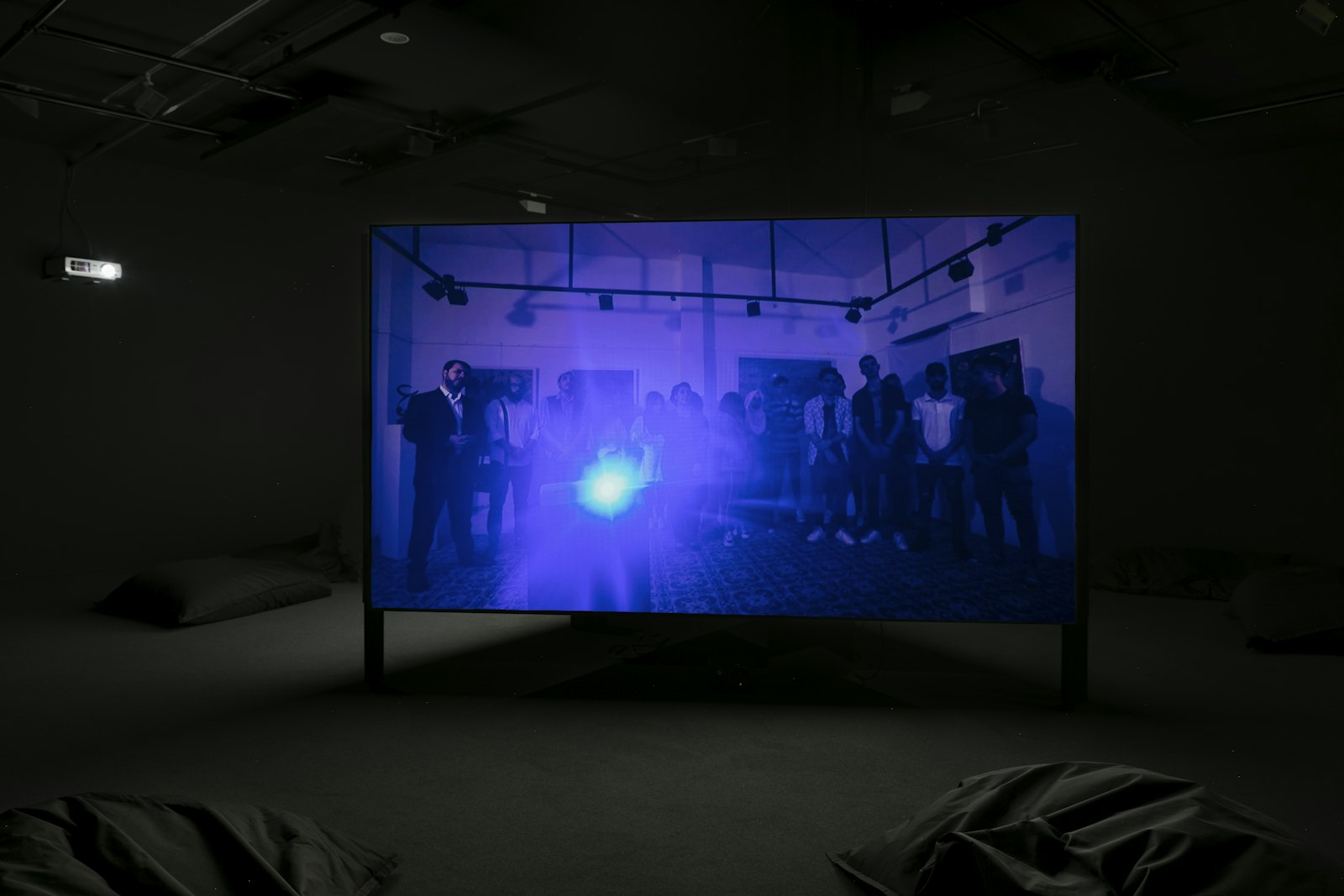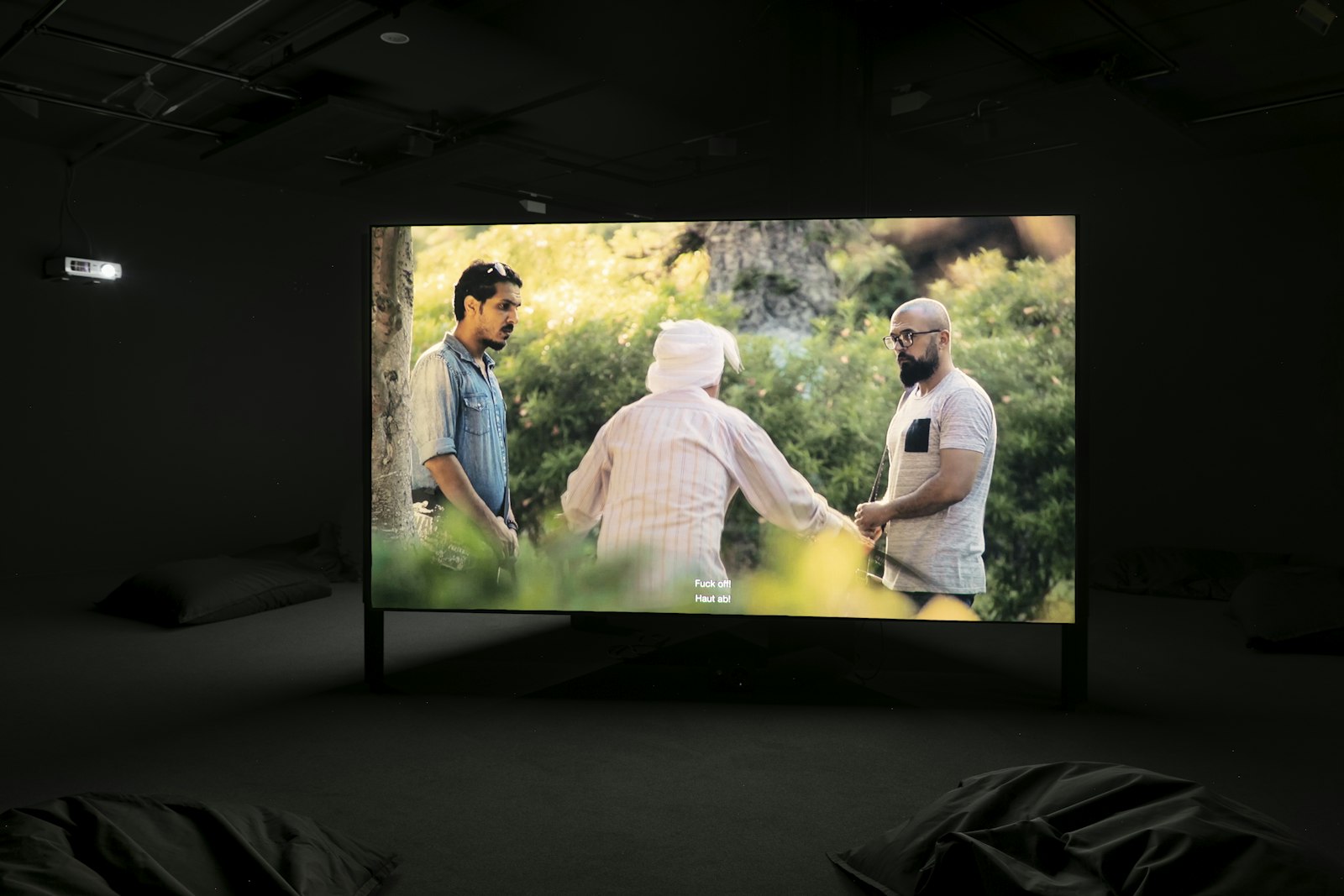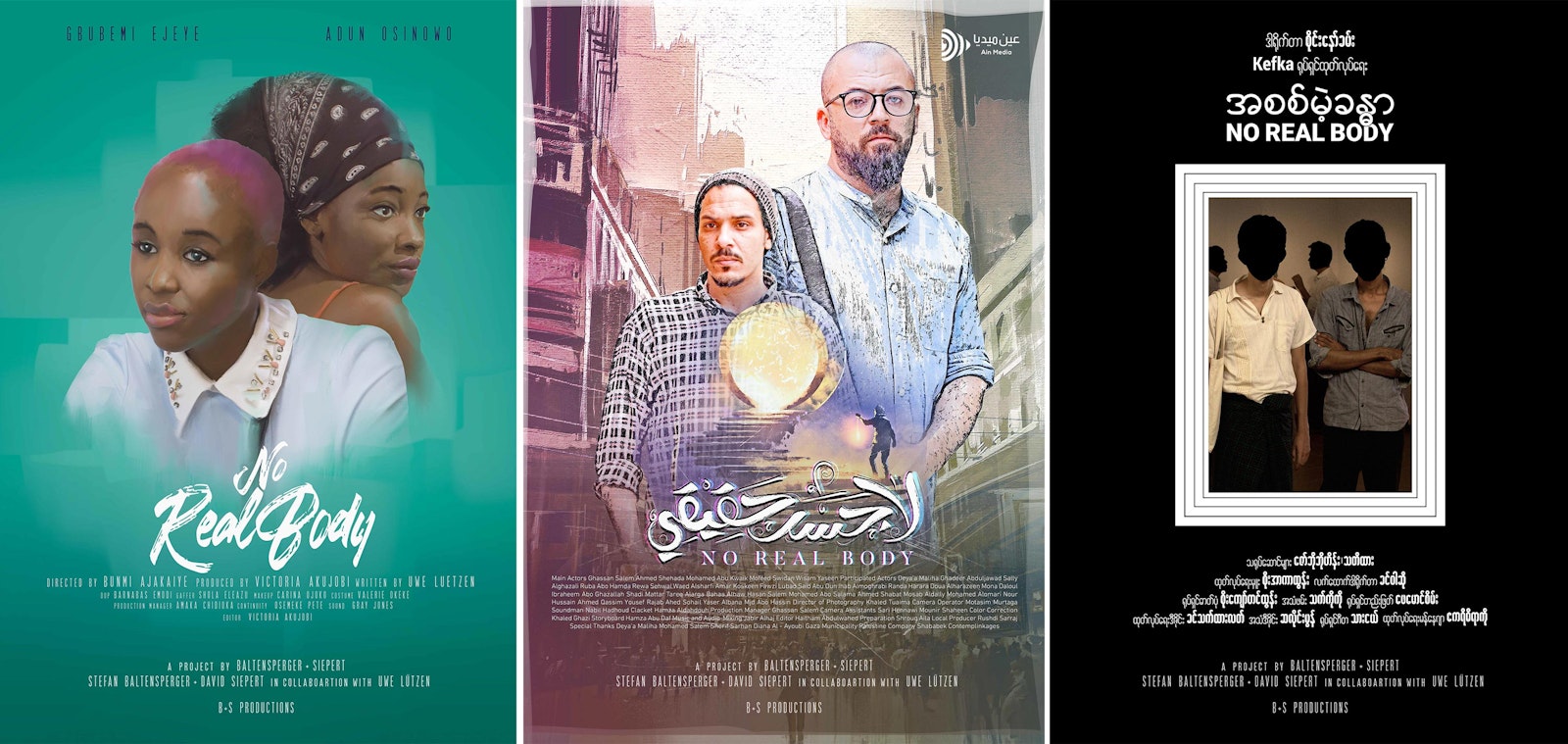SITUATION #195





How would your life have evolved if you had grown up in a different place, influenced by completely different social and political realities? This question is at the heart of the latest work of Baltensperger + Siepert. Taking the duo’s everyday working life as a starting point for a fictional story, they joined forces with screenwriter Uwe Lützen to script an instructional screenplay which was subsequently interpreted and implemented by three different film production companies: one based in Yangon, Myanmar (Soe Arkar Htun & Sai Naw Kham; Kefka Film Productions), one in Lagos, Nigeria (Victoria Akujobi & Bunmi Ajakaiye) and one in Gaza (Rushdi Al-Sarraj & Ahmed Hassouna; Ain Media).
The experimental setup spawned three 16-minute feature films based on the same narrative yet shaped in the light of different cultural codes. More than just revealing these codes, however, the complex interweaving of images and imaginaries directs the gaze back at the audience who find themselves confronted with a whole range of questions. Who are the authors of these parallel stories? For which audience were they produced? When Nigerian Nollywood, the second largest site for film production in the world, contributes its perspective – generally meant to target the African continent – to a commission from a Western employer, what reality is staged, what gaze and spectator is imagined? Is there room for artistic exploration in Gaza, a place primarily known as a war zone through media reporting? And what expectations do we as Western Europeans have of the film scene in Myanmar, which after decades of military dictatorship is beginning to open up to the rest of the world? The three-channel installation shown for the first time at Fotomuseum Winterthur creates a form of spectatorship in which the tension of intersecting and entangled gazes becomes palpable.
More by Baltensperger + Siepert: baltensperger-siepert.com
More by Uwe Lützen: luetzen.me
More by Rushdi Al-Sarraj & Ahmend Hassouna, Ain Media: ain-media.com
BALTENSPERGER + SIEPERT IN CONVERSATION WITH DAMIAN CHRISTINGER
Damian Christinger: At first glance, the film installation No Real Body—The Fiction of a Singular Identity seems almost like a metaphysical experimental arrangement. You gave three film production teams in three different locations – Nigeria, Myanmar, and Gaza – the same set of directions in the form of a screenplay by Uwe Lützen, which follows strict timings but still leaves room for improvisation in certain places, as well as some stipulations, such as refraining from showing concrete works of art. What was the starting point for this work and how did you develop it from there?
Baltensperger + Siepert: A few years ago we met the screenwriter Uwe Lützen at a barbecue at the home of a writer friend of ours. Late in the evening, letting our imaginations run wild, we found a shared interest – the construction of reality through fiction – that ultimately led to the desire to continue inventing stories together and to turn it into a project.
Many of our works are developed over long periods of time. In retrospect, the work The Reproduction of the Self (2015) was arguably also pivotal to the idea of No Real Body. For The Reproduction of the Self we intensively grappled with the question of who we actually are as Baltensperger + Siepert – how we understand ourselves. Through this we came to the conclusion that what makes our collaboration special is the way in which we design our processes rather than us as people. Since processes can be learned and transferred, when we were invited to the Ural Biennial in 2015 we hired two people in Yekaterinburg to be Baltensperger + Siepert in our place and to develop a work for the Biennial with instructions on how the process of our collaboration works.
This idea of disembodiment can also be found in No Real Body. At the very beginning there was just this idea that Uwe Lützen could develop a screenplay for our own everyday lives. We were interested in liberating ourselves from the constraints of our own decisions and at the same time unfurling the fantasies of another person within the framework of our own lives. As we travel a lot for exhibitions, our focus shifted toward the issue of location and how it influences the development of a person. How would our lives have developed if we had been born in a different place and in a different situation? This simple question led us to No Real Body.
Together we set out the rough framework and the mechanisms of the project, and Uwe Lützen developed the screenplay “Two artists working on a project and addressing the essential issues of their time.” What is meant by “artists”, what the “essential issues of our time” are, and how these are situated in the local context are explicitly omitted from the text, so it was up to the local production teams to answer these questions based on the reality of their own lives and to write this into the film. Just like with The Reproduction of the Self in Yekaterinburg, the authorship of the work is blended here, too. For one thing, the “body” of Baltensperger + Siepert is expanded to include Uwe Lützen, and then there are also the three production teams, with a total of more than one hundred people, who all bring their own experiences and interpretations into this body and the project.
DC: The three geographical and cultural situations depicted correspond to hypothetical and plausible configurations from the life and work of Baltensperger + Siepert. The resulting films are shown simultaneously as a walk-through installation in the exhibition SITUATIONS/The Right To Look. What is the power of this “what if” for you both?
B+S: Fictional space, and therefore art, opens up a space of possibility for different scenarios to be run through without affecting the space that is collectively perceived as reality. As a result of this we develop visions, ideas, an inner image of who we would like to be and where we would like to go. The idea of an alternative reality, influenced by past decisions, does not interest us so much. These thoughts are pointless, as they do not make any constructive contribution to the present. What is more interesting for us is the question of how we can handle what is now being portrayed.
The disorientation caused by shifting our existence into other cultural spaces would ideally open up access to new “worlds” in the sense of newly possible configurations. But it also calls into question the unique and self-evident nature of our own standpoint. In concrete terms, one could also speak of an undermining of the concept of identity as demarcation. This superimposition makes it clear that – despite superficial differences – we are also the same, we have the same problems and questions, and are trapped in the same everyday banality.
DC: The question of biography and fate, along with the concept of character, identity and demarcation, is also raised by Walter Benjamin in his essay “Fate and Character”, in which he writes: “Not only is it impossible to determine in a single case what finally is to be considered a function of character and what a function of fate in a human life (this would make no difference here if the two only merged in experience); the external world that the active man encounters can also in principle be reduced, to any desired degree, to his inner world, and his inner world similarly to his outer world, indeed regarded in principle as one and the same thing.” This amalgamation of fate and character as a basic characteristic of human action ultimately leads to an almost fateless state, he argues further, for a person takes control of their destiny by permitting this interplay between a possible future and their character. As artists, can you take control of your destiny in a special way?
B+S: The problem with construction through fate and character is the assumption of an innate character. Within these prescribed parameters of fate and character, our actions, and therefore history, would thus be nothing more than a sequence of purely logical consequences. In this configuration, a person becomes a reactive object that only reacts to their environment within specifically designated pathways. As a hypothesis, this is not very appealing, because it deprives us of our subjectivity.
Nonetheless, fate is pivotal to the development of our real lives. We become aware of this when we travel and entertain the fantasy of who we would have become if we had been born in this or that place, for example. This results in the proposition that the reality of our life is formed by aspects that we did not choose ourselves, such as our place of birth.
We approach this topic in No Real Body, hence the title of the work and the disembodiment. Contrary to the concept of identity, which describes demarcation, we are interested in intersections and convergences. We would like to be able to develop an idea of what our everyday reality would look like in another location, as these fictional imaginative spaces free us from our “prescribed” fate. They create alternative realities that enable us to interrogate our thinking and understanding.
DC: But aren’t you also partially taking control of the fate of those involved in the different locations?
B+S: Yes, absolutely. The fact is that No Real Body has placed demands on the lives of many people and has also involved them in the creative process as active authors; the teams in Gaza, Yangon and Lagos were involved in the construction of this imaginative space. The starting point – namely, that the teams were given no instructions other than the script and had to implement their own interpretation of it – ostensibly suggests a great deal of freedom. But the more freedom one is given in the implementation of an assignment, the more one has to reveal of oneself. So the production teams had no choice but to draw from the pool of their own everyday realities and life stories. In return they received financial compensation. The system in which they were remunerated for their experiences – which were shaped by their fate – is one in which there are major geopolitical distribution inequalities. This aspect should not be forgotten.
DC: You are addressing a global political issue here, but at first glance, one might think that this work is very personal, or at least related to the art world?
B+S: The socially relevant issues of our time are global, but the process of thinking is subjective and personal. Particular aspects that unfold in a specific place often refer to a larger whole, so starting from aspects of a local nature can help to approach and explore a topic of great importance.
Metaphorically speaking, our concepts are like seeds that begin to sprout within the framework we have laid out. In No Real Body the seeds are the instructions in the script. The narrative of the story is still close to our own everyday reality – this everyday reality is the only one we can describe. Everything that happens afterwards has nothing to do with us. The three film teams appropriated the story through their interpretations and created their very own fiction from it.
The relationship between fiction and reality fascinates us. In the medium of film, this is always present through the fictional narrative, which, although it partly alludes to real circumstances, can be clearly identified as fiction. The film creates a pull that allows the viewer to immerse themselves in this fictional reality and we subjectively weave the memories of this narration into our personal world model. Reality becomes fiction, which becomes reality, which becomes fiction. Uwe Lützen repeatedly refers to a quotation by Stephen King on this subject: “Fiction is a lie. And good fiction is the truth inside the lie.” The narrative of No Real Body is also located in this spiral. It begins in the local art context, and is then transformed by the film production apparatus at three different locations, before finding its way back into a local art context.
DC: Your earlier works were more obviously social. How would you relate No Real Body to Invisible Philosophy (2016/2017), for example?
B+S: No Real Body is a complex construct. The narrative level and visual language are initially dominant. However, the experimental set-up and the interrelation of the different interpretations provide an opportunity for profound reflections on our society and existence.
In Invisible Philosophy, the political and social aspects are more obvious due to the collaboration with day labourers in China. The work inevitably overlaps with a much discussed societal topic. If we had created the same work with harvest workers in Switzerland, this superficial interpretation would have probably turned out differently. The decision to create this work with day labourers in China was therefore an aesthetic one – one that impacts the perception.
DC: Until now, your works have had a strong documentary aspect, even if you always transform it in something else. In No Real Body you experiment with narrative formats. Are you fundamentally changing your approach?
B+S: Yes, certainly. Repetitions bore us and with each work we try to interrogate the fundamental structures of our previous works and develop them further.
The constant is the definition of our collaboration. We define Baltensperger + Siepert as a body that is not limited to our physical bodies. Through this open process of collaboration, often with many different project participants, things emerge that transcend our own personal ideas and possibilities. No Real Body was our first collaboration with professional film production companies. We gave them complete control over many creative aspects, whereas in previous projects we had always retained full control of the visual realisation.
DC: In Introduction to a Poetics of Diversity, Édouard Glissant writes: “We are now faced with the question of how the imaginary, the mentality, and the intellect of today’s human communities can be transformed in such a way that conflicts within long-established cultures are no longer seen as absolute conflicts and that ethnic and national conflicts are no longer seen as an inevitable necessity in creole countries.” This is a question that is again becoming urgent in a post-migration – namely, creolized – Switzerland in these times of pandemic. No Real Body could also be read as an "empathy machine”, as an invitation to accept our own creolization and to show compassion for others, because it could be us. Too much interpretation?
B+S: We like your interpretation very much. We appreciate Édouard Glissant for his literary approach to theory. Some of his books have left a lasting impression on how we think. With this question of migration and creolization you are addressing one of the important issues of our time: it is the question of the terms of our cohabitation, how we perceive ourselves and others, how we understand that we are equal as human beings, but that each of us also has our own story to tell.
Something we aspire to in our work is to leave the space for interpretation open. Ideally, a work opens up a field that seeks to be explored and in which we can immerse ourselves with relish. Even though we are completely behind your interpretation, we do not want to align ourselves completely with it, because there are still many other aspects that are important to us. We could name some of them, but then there are also some unnameable aspects, whose presence we sense but which we cannot articulate.
Damian Christinger (*1975, Zurich) studied Asian Art History and Intercultural Studies. He works as an independent curator, publicist and lectures at the University of the Arts Zurich on transcultural theory and practice. His main focus is on the construction of “the other” in intercultural relations and art history.
Kindly supported by Schweizerische Eidgenossenschaft, Embassy of Switzerland in Myanmar, Erna und Curt Burgauer Stiftung, S. Eustachius Stiftung.
Cluster: The Right to Look